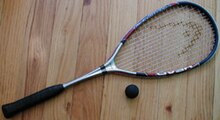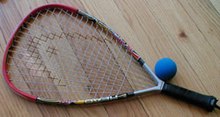Reket — разлика између измена
. ознака: уклоњено преусмерење |
|||
| Ред 1: | Ред 1: | ||
[[File:Squash-racquet-and-ball.jpg|thumb|Squash racket and ball]] |
|||
#Преусмери [[Тениски рекет]] |
|||
[[File:racquetball-racquet-and-bal.jpg|thumb|Racquetball racket and ball]] |
|||
{{rut}} |
|||
'''Reket ''' is a sports implement consisting of a handled frame with an open hoop across which a network of strings or catgut is stretched tightly.<ref name="grammarist">{{cite web | title = Racket vs. racquet | work = Grammarist | url = http://grammarist.com/spelling/racket-racquet/ | accessdate = 5 September 2012 }}</ref> It is used for striking a [[ball]] or [[shuttlecock]] in games such as [[squash (sport)|squash]], [[tennis]], [[racquetball]], and [[badminton]]. Collectively, these games are known as [[racket sports]]. Racket design and manufacturing has changed considerably over the centuries. |
|||
The frame of rackets for all sports was traditionally made of solid wood (later [[engineered wood|laminated wood]]) and the strings of animal intestine known as [[catgut]]. The traditional racket size was limited by the strength and weight of the wooden frame which had to be strong enough to hold the strings and stiff enough to hit the ball or shuttle. Manufacturers started adding non-wood laminates to wood rackets to improve stiffness. Non-wood rackets were made first of steel, then of aluminum, and then carbon fiber composites. Wood is still used for [[real tennis]], [[rackets (sport)|rackets]], and [[xare]]. Most rackets are now made of composite materials including [[carbon fiber]] or [[fiberglass]], metals such as [[titanium]] alloys, or [[ceramic]]s. |
|||
Catgut has partially been replaced by synthetic materials including [[nylon]], [[polyamide]], and other polymers. Rackets are restrung when necessary, which may be after every match for a professional. Despite the name, "catgut" has never been made from any part of a cat. |
|||
== Spelling == |
|||
''Racket'' is the standard spelling of the word. ''Racquet'' is an alternative spelling<ref>{{cite web | title = Racket | work = Merriam-Webster | url = http://www.merriam-webster.com/dictionary/racket | accessdate = 5 September 2012 }}</ref><ref>{{cite web | title = Racket | work = Oxford Dictionaries | url = http://oxforddictionaries.com/definition/english/racket | accessdate = 26 June 2013 }}</ref> used more commonly in certain sports ([[Squash (sport)|squash]], [[racquetball]], [[badminton]]) and less commonly in others. The [[International Tennis Federation]] uses ''racket'' exclusively. ''Racket'' is the older spelling and is the predominant spelling by a large margin;<ref name="grammarist"/> it has been in use since the 16th century, with ''racquet'' only appearing in the 19th century as a French-influenced variant of ''racket''.<ref name="grammarist"/> |
|||
==Etymology== |
|||
The origin of the term "racket" is unclear. According to a popular belief first published by tennis player [[Malcolm Whitman]] in 1932, the expression comes from the Arabic term ''rahat al-yad'', meaning "palm of hand".<ref>{{cite book|last=Whitman|first=Malcolm D.|title=Tennis : Origins and Mysteries|year=1932|publisher=Dover Publications|location=Mineola, N.Y.|isbn=0486433579|edition=Dover}}</ref> Modern research however, holds this thesis in a highly questionable light.<ref>{{cite book|last=Gillmeister|first=Heiner|title=Tennis : A Cultural History|url=https://archive.org/details/tennisculturalhi0000gill|url-access=registration|year=1998|publisher=New York University Press|location=Washington Square, N.Y.|isbn=081473121X| pages=[https://archive.org/details/tennisculturalhi0000gill/page/5 5]}}</ref> Instead, the term is more likely to be derived from the [[Flemish]] word "raketsen" which is itself derived from [[Middle French]] "rachasser", meaning "to strike (the ball) back".<ref>{{cite book|last=Gillmeister|first=Heiner|title=Tennis : A Cultural History|url=https://archive.org/details/tennisculturalhi0000gill|url-access=registration|year=1998|publisher=New York University Press|location=Washington Square, N.Y.|isbn=081473121X| pages=[https://archive.org/details/tennisculturalhi0000gill/page/123 123]}}</ref> |
|||
== Badminton == |
|||
[[Image:Heads of badminton raquets.jpg|right|thumb|Badminton rackets]] |
|||
[[Badminton]] rackets are light, with top quality rackets weighing between about 70 and 95 grams (with guts ). Modern rackets are composed of carbon fiber composite (graphite reinforced plastic), which may be augmented by a variety of materials. Carbon fiber has an excellent strength to weight ratio, is stiff, and gives excellent [[kinetic energy]] transfer. Before the adoption of carbon fiber composite, rackets were made of wood to their excessive weight and cost. |
|||
There is a wide variety of racket designs, although the badminton racket size and shape are limited by the Laws. Different rackets have playing characteristics that appeal to different players. The traditional oval head shape is still available, but an isometric head shape is increasingly common in new rackets. |
|||
Various companies have emerged but Yonex of Japan and Li-Ning of China are the dominant players in the market. The majority of top tournaments are sponsored by these companies. Every year new technology is introduced by these companies but predominantly, all rackets are made of carbon graphite composite. |
|||
== Reference == |
|||
{{Reflist}} |
|||
== Literatura == |
|||
{{Refbegin}} |
|||
* {{cite book |author=ITTF |date=August 2018 |accessdate=31 May 2019 |title=The International Table Tennis Federation Handbook 2019 |url=https://www.ittf.com/wp-content/uploads/2019/11/2019ITTFHandbook_v2.pdf}} |
|||
* {{cite journal|last1=Varenberg|first1=M.|last2=Varenberg|first2=A.|date=2012|title=Table tennis rubber: Tribologicaly characterization|journal=Tribology Letters|volume=47|issue=1|pages=51–56|doi=10.1007/s11249-012-9961-4}} |
|||
{{Refend}} |
|||
== Spoljašnje veze == |
|||
{{Commons category-lat|Racquets}} |
|||
{{Refbegin|30em}} |
|||
* -{[http://www.sil.si.edu/exhibitions/doodles/cf/doodles_enlarge.cfm?id_image=169 Tennis racket design by Howard Head]; (1974) Smithsonian Institution Libraries}- |
|||
* -{[http://tennis.about.com/od/racquetsballsstringing/a/evolmodracquet.htm The History of Tennis Racquets — Evolution of the Modern Racquet]}- |
|||
* -{Gelberg, J. Nadine, [https://web.archive.org/web/20080123071650/http://www.americanheritage.com/articles/magazine/it/1997/4/1997_4_56.shtml "The Big Technological Tennis Upset"], ''Invention & Technology'' magazine, 1997}- |
|||
* -{[https://sportsedtv.com/sport/tennis/how-to-choose-a-tennis-racquet How to choose a tennis racquet] video}- |
|||
* {{cite web|title=About.com:Tennis Q/A How often to restring|url=http://tennis.about.com/od/tennisstringsfaq/f/faqstrings35.htm|author=Jeff Cooper|access-date=2008-02-20|url-status=dead|archive-url=https://web.archive.org/web/20080209171306/http://tennis.about.com/od/tennisstringsfaq/f/faqstrings35.htm|archive-date=2008-02-09|df=}} |
|||
* {{cite web |title=About.com:Tennis Q/A What's the best string tension for more power? |url=http://tennis.about.com/od/tennisstringsfaq/f/faqstrings25.htm |author=Jeff Cooper |access-date=2008-02-20 |url-status=dead |archive-url=https://web.archive.org/web/20071219180817/http://tennis.about.com/od/tennisstringsfaq/f/faqstrings25.htm |archive-date=2007-12-19 |df= }} |
|||
* {{cite web |title=About.com:Tennis Q/A What's the best string tension for more control? |url=http://tennis.about.com/od/tennisstringsfaq/f/faqstrings26.htm |author=Jeff Cooper |access-date=2008-02-20 |url-status=dead |archive-url=https://web.archive.org/web/20080207210100/http://tennis.about.com/od/tennisstringsfaq/f/faqstrings26.htm |archive-date=2008-02-07 |df= }} |
|||
* {{cite web |title=About.com:Tennis Q/A Q. What's the best string tension to protect my arm? |url=http://tennis.about.com/od/tennisstringsfaq/f/faqstrings28.htm |author=Jeff Cooper |access-date=2008-02-20 |url-status=dead |archive-url=https://web.archive.org/web/20071216225552/http://tennis.about.com/od/tennisstringsfaq/f/faqstrings28.htm |archive-date=2007-12-16 |df= }} |
|||
* {{cite web |url= http://www.megaspin.net/info/equip.asp|title= Table Tennis Information - Equipment maintenance|accessdate=2007-07-10 |last=|first=|authorlink= |date= |year= |month= |format= |website= |publisher=Megaspin |pages= |language= |quote= }} |
|||
{{Refend}} |
|||
{{Authority control-lat}} |
|||
[[Категорија:Спортска опрема]] |
|||
Верзија на датум 19. јун 2020. у 01:40


Један корисник управо ради на овом чланку. Молимо остале кориснике да му допусте да заврши са радом. Ако имате коментаре и питања у вези са чланком, користите страницу за разговор.
Хвала на стрпљењу. Када радови буду завршени, овај шаблон ће бити уклоњен. Напомене
|
Reket is a sports implement consisting of a handled frame with an open hoop across which a network of strings or catgut is stretched tightly.[1] It is used for striking a ball or shuttlecock in games such as squash, tennis, racquetball, and badminton. Collectively, these games are known as racket sports. Racket design and manufacturing has changed considerably over the centuries.
The frame of rackets for all sports was traditionally made of solid wood (later laminated wood) and the strings of animal intestine known as catgut. The traditional racket size was limited by the strength and weight of the wooden frame which had to be strong enough to hold the strings and stiff enough to hit the ball or shuttle. Manufacturers started adding non-wood laminates to wood rackets to improve stiffness. Non-wood rackets were made first of steel, then of aluminum, and then carbon fiber composites. Wood is still used for real tennis, rackets, and xare. Most rackets are now made of composite materials including carbon fiber or fiberglass, metals such as titanium alloys, or ceramics.
Catgut has partially been replaced by synthetic materials including nylon, polyamide, and other polymers. Rackets are restrung when necessary, which may be after every match for a professional. Despite the name, "catgut" has never been made from any part of a cat.
Spelling
Racket is the standard spelling of the word. Racquet is an alternative spelling[2][3] used more commonly in certain sports (squash, racquetball, badminton) and less commonly in others. The International Tennis Federation uses racket exclusively. Racket is the older spelling and is the predominant spelling by a large margin;[1] it has been in use since the 16th century, with racquet only appearing in the 19th century as a French-influenced variant of racket.[1]
Etymology
The origin of the term "racket" is unclear. According to a popular belief first published by tennis player Malcolm Whitman in 1932, the expression comes from the Arabic term rahat al-yad, meaning "palm of hand".[4] Modern research however, holds this thesis in a highly questionable light.[5] Instead, the term is more likely to be derived from the Flemish word "raketsen" which is itself derived from Middle French "rachasser", meaning "to strike (the ball) back".[6]
Badminton

Badminton rackets are light, with top quality rackets weighing between about 70 and 95 grams (with guts ). Modern rackets are composed of carbon fiber composite (graphite reinforced plastic), which may be augmented by a variety of materials. Carbon fiber has an excellent strength to weight ratio, is stiff, and gives excellent kinetic energy transfer. Before the adoption of carbon fiber composite, rackets were made of wood to their excessive weight and cost.
There is a wide variety of racket designs, although the badminton racket size and shape are limited by the Laws. Different rackets have playing characteristics that appeal to different players. The traditional oval head shape is still available, but an isometric head shape is increasingly common in new rackets. Various companies have emerged but Yonex of Japan and Li-Ning of China are the dominant players in the market. The majority of top tournaments are sponsored by these companies. Every year new technology is introduced by these companies but predominantly, all rackets are made of carbon graphite composite.
Reference
- ^ а б в „Racket vs. racquet”. Grammarist. Приступљено 5. 9. 2012.
- ^ „Racket”. Merriam-Webster. Приступљено 5. 9. 2012.
- ^ „Racket”. Oxford Dictionaries. Приступљено 26. 6. 2013.
- ^ Whitman, Malcolm D. (1932). Tennis : Origins and Mysteries (Dover изд.). Mineola, N.Y.: Dover Publications. ISBN 0486433579.
- ^ Gillmeister, Heiner (1998). Tennis : A Cultural History
 . Washington Square, N.Y.: New York University Press. стр. 5. ISBN 081473121X.
. Washington Square, N.Y.: New York University Press. стр. 5. ISBN 081473121X.
- ^ Gillmeister, Heiner (1998). Tennis : A Cultural History
 . Washington Square, N.Y.: New York University Press. стр. 123. ISBN 081473121X.
. Washington Square, N.Y.: New York University Press. стр. 123. ISBN 081473121X.
Literatura
- ITTF (август 2018). The International Table Tennis Federation Handbook 2019 (PDF). Приступљено 31. 5. 2019.
- Varenberg, M.; Varenberg, A. (2012). „Table tennis rubber: Tribologicaly characterization”. Tribology Letters. 47 (1): 51—56. doi:10.1007/s11249-012-9961-4.
Spoljašnje veze
- Tennis racket design by Howard Head; (1974) Smithsonian Institution Libraries
- The History of Tennis Racquets — Evolution of the Modern Racquet
- Gelberg, J. Nadine, "The Big Technological Tennis Upset", Invention & Technology magazine, 1997
- How to choose a tennis racquet video
- Jeff Cooper. „About.com:Tennis Q/A How often to restring”. Архивирано из оригинала 2008-02-09. г. Приступљено 2008-02-20.
- Jeff Cooper. „About.com:Tennis Q/A What's the best string tension for more power?”. Архивирано из оригинала 2007-12-19. г. Приступљено 2008-02-20.
- Jeff Cooper. „About.com:Tennis Q/A What's the best string tension for more control?”. Архивирано из оригинала 2008-02-07. г. Приступљено 2008-02-20.
- Jeff Cooper. „About.com:Tennis Q/A Q. What's the best string tension to protect my arm?”. Архивирано из оригинала 2007-12-16. г. Приступљено 2008-02-20.
- „Table Tennis Information - Equipment maintenance”. Megaspin. Приступљено 2007-07-10.
